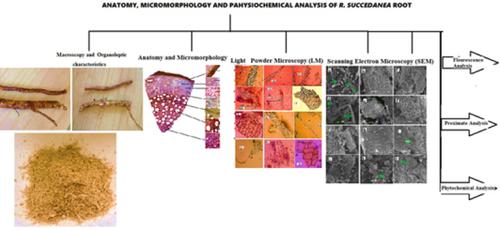当前位置:
X-MOL 学术
›
Microsc. Res. Tech.
›
论文详情
Our official English website, www.x-mol.net, welcomes your
feedback! (Note: you will need to create a separate account there.)
Anatomy, micromorphology, and physiochemical analysis of Rhus succedanea var. himalaica root
Microscopy Research and Technique ( IF 2.0 ) Pub Date : 2020-01-07 , DOI: 10.1002/jemt.23430 Shafqat Ali Khan 1 , Barkatullah 1 , Behramand Khan 2
Microscopy Research and Technique ( IF 2.0 ) Pub Date : 2020-01-07 , DOI: 10.1002/jemt.23430 Shafqat Ali Khan 1 , Barkatullah 1 , Behramand Khan 2
Affiliation

|
Root micromorphology can play a vital role in the systematics of angiosperms to understand the complexity among different genera and species. Present study is about microscopic and physiochemical evaluation of Rhus succedanea root belonging to the family Anacardiaceae. Various organoleptic characteristics of root were studied. Microscopy showed that transverse section of the root appeared rounded and presented a typical histological differentiation having different average cells length and width. Under light microscopy and scanning electron microscopy, the powder revealed the existence of pitted xylem vessels, phloem sieve elements, phloem fibers and cork cells, and so forth. Fluorescence study of the powder showed various shades of color that gives a valuable information regarding characterization, authentication, and identification of the plant material. These documented information can be acted as record and monograph of a specific plant materials. Nutritional composition of root showed that Ash, fat, protein, carbohydrates, and total gross energy were higher in summer as compared to winter season. On the other hand, moisture and fibers were higher in winter and declined in summer. Root powder gave highest extractive value (37.3%) in methanol and showed the presence of various groups of secondary metabolites qualitatively while, quantitatively flavonoids (0.18 mg/g) was detected in highest amount. The above parameters, being reported for the first time and are significant toward establishing the microscopic and pharmacognostic standards for future identification and authentication of genuine herbal drug. Root micromorphology can be used as an additional tool to aid description and to distinguish many complex taxa and that is of significant value for the taxonomic assessment of this genera and species.
中文翻译:

大花鼠李的解剖学,显微形态和理化分析。喜马拉雅根
根的微观形态在被子植物的系统中起着至关重要的作用,以了解不同属和种之间的复杂性。目前的研究是关于属于Anacardiaceae科的Rus succedanea根的显微和理化评价。研究了根的各种感官特性。显微镜检查显示根的横切面呈圆形,并呈现典型的组织学分化,其平均细胞长度和宽度均不同。在光学显微镜和扫描电子显微镜下,该粉末显示存在点蚀的木质部血管,韧皮部筛网元素,韧皮部纤维和软木细胞等。粉末的荧光研究显示出各种颜色的深浅,为植物的特性鉴定,鉴定和鉴定提供了有价值的信息。这些记录的信息可以用作特定植物材料的记录和专论。根的营养成分表明,夏季的灰分,脂肪,蛋白质,碳水化合物和总总能量比冬季高。另一方面,冬季的水分和纤维含量较高,而夏季则下降。根粉在甲醇中的提取价值最高(37.3%),并且定性显示了各种次生代谢物的存在,而定量检测到的黄酮含量最高(0.18 mg / g)。上述参数是首次报道,对于建立微观和药理学标准以用于将来对真正草药的鉴定和认证具有重要意义。根微形态学可以用作辅助描述和区分许多复杂类群的附加工具,这对于该属和物种的分类学评估具有重要价值。3%)在甲醇中,定性显示了不同种类的次级代谢产物的存在,同时,黄酮类化合物的含量最高(0.18毫克/克)。上述参数是首次报道,对于建立微观和药理学标准以用于将来对真正草药的鉴定和认证具有重要意义。根微形态学可以用作辅助描述和区分许多复杂类群的附加工具,这对于该属和物种的分类学评估具有重要价值。3%)在甲醇中,定性显示了不同种类的次级代谢产物的存在,同时,黄酮类化合物的含量最高(0.18毫克/克)。上述参数是首次报道,对于建立微观和药理学标准以用于将来对真正草药的鉴定和认证具有重要意义。根微形态学可以用作辅助描述和区分许多复杂类群的附加工具,这对于该属和物种的分类学评估具有重要价值。首次被报道,对建立微观和药理学标准以用于未来对真正草药的鉴定和认证具有重要意义。根微形态学可以用作辅助描述和区分许多复杂类群的附加工具,这对于该属和物种的分类学评估具有重要价值。首次被报道,对于建立微观和药理学标准以用于未来对真正草药的鉴定和认证具有重要意义。根微形态学可以用作辅助描述和区分许多复杂类群的附加工具,这对于该属和物种的分类学评估具有重要价值。
更新日期:2020-01-07
中文翻译:

大花鼠李的解剖学,显微形态和理化分析。喜马拉雅根
根的微观形态在被子植物的系统中起着至关重要的作用,以了解不同属和种之间的复杂性。目前的研究是关于属于Anacardiaceae科的Rus succedanea根的显微和理化评价。研究了根的各种感官特性。显微镜检查显示根的横切面呈圆形,并呈现典型的组织学分化,其平均细胞长度和宽度均不同。在光学显微镜和扫描电子显微镜下,该粉末显示存在点蚀的木质部血管,韧皮部筛网元素,韧皮部纤维和软木细胞等。粉末的荧光研究显示出各种颜色的深浅,为植物的特性鉴定,鉴定和鉴定提供了有价值的信息。这些记录的信息可以用作特定植物材料的记录和专论。根的营养成分表明,夏季的灰分,脂肪,蛋白质,碳水化合物和总总能量比冬季高。另一方面,冬季的水分和纤维含量较高,而夏季则下降。根粉在甲醇中的提取价值最高(37.3%),并且定性显示了各种次生代谢物的存在,而定量检测到的黄酮含量最高(0.18 mg / g)。上述参数是首次报道,对于建立微观和药理学标准以用于将来对真正草药的鉴定和认证具有重要意义。根微形态学可以用作辅助描述和区分许多复杂类群的附加工具,这对于该属和物种的分类学评估具有重要价值。3%)在甲醇中,定性显示了不同种类的次级代谢产物的存在,同时,黄酮类化合物的含量最高(0.18毫克/克)。上述参数是首次报道,对于建立微观和药理学标准以用于将来对真正草药的鉴定和认证具有重要意义。根微形态学可以用作辅助描述和区分许多复杂类群的附加工具,这对于该属和物种的分类学评估具有重要价值。3%)在甲醇中,定性显示了不同种类的次级代谢产物的存在,同时,黄酮类化合物的含量最高(0.18毫克/克)。上述参数是首次报道,对于建立微观和药理学标准以用于将来对真正草药的鉴定和认证具有重要意义。根微形态学可以用作辅助描述和区分许多复杂类群的附加工具,这对于该属和物种的分类学评估具有重要价值。首次被报道,对建立微观和药理学标准以用于未来对真正草药的鉴定和认证具有重要意义。根微形态学可以用作辅助描述和区分许多复杂类群的附加工具,这对于该属和物种的分类学评估具有重要价值。首次被报道,对于建立微观和药理学标准以用于未来对真正草药的鉴定和认证具有重要意义。根微形态学可以用作辅助描述和区分许多复杂类群的附加工具,这对于该属和物种的分类学评估具有重要价值。









































 京公网安备 11010802027423号
京公网安备 11010802027423号